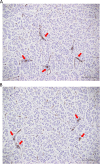Gestational heat stress alters skeletal muscle gene expression profiles and vascularity in fetal pigs in a sexually dimorphic manner
- PMID: 35836286
- PMCID: PMC9284688
- DOI: 10.1186/s40104-022-00730-2
Gestational heat stress alters skeletal muscle gene expression profiles and vascularity in fetal pigs in a sexually dimorphic manner
Abstract
Background: There is evidence that sow heat stress (HS) during gestation affects fetal development with implications for impaired muscle growth. We have previously demonstrated that maternal HS during early to mid-gestation compromised muscle fibre hyperplasia in developing fetal pigs. Thus, we hypothesised these phenotypic changes are associated with a change in expression of genes regulating fetal skeletal muscle development and metabolism. To test this, at d 60 of gestation, RNA sequencing and immunohistochemistry were performed on fetal longissimus dorsi (LD) muscle biopsies collected from pregnant gilts that had experienced either thermoneutral control (CON, 20 °C, n = 7 gilts, 18 LD samples) or controlled HS (cyclic 28 to 33 °C, n = 8 gilts, 23 LD samples) conditions for 3 weeks.
Results: A total of 282 genes were differentially expressed between the HS and CON groups in female LD muscles (false discovery rate (FDR) ≤ 0.05), whereas no differentially expressed genes were detected in male LD muscles between the two groups (FDR > 0.05). Gestational HS increased the expression of genes associated with transcription corepressor activity, adipogenesis cascades, negative regulation of angiogenesis and pro-inflammatory signalling in female LD muscles. Immunohistochemical analyses revealed a decreased muscle vascularity density in fetuses from HS group for both sexes compared to those from the CON group (P = 0.004).
Conclusions: These results reveal gilt HS during early to mid-gestation altered gene expression profiles in fetal LD muscles in a sexually dimorphic manner. The molecular responses, including transcription and angiogenesis repressions and enhanced adipogenesis cascades, were exclusively observed in females. However, the associated reductions in muscle vascularity were observed independently of sexes. Collectively this may indicate female fetal pigs are more adaptive to gestational HS in terms of gene expression changes, and/or there may be sexually dimorphic differences with respect to the timing of muscle molecular responses to gestational HS.
Keywords: Adipogenesis; Angiogenesis; Fetal pig; Gestation; Heat stress; Sexual dimorphism; Skeletal muscle; Sows.
© 2022. The Author(s).
Conflict of interest statement
The authors declare that they have no competing interests.
Figures




Similar articles
-
Maternal Heat Stress Alters Expression of Genes Associated with Nutrient Transport Activity and Metabolism in Female Placentae from Mid-Gestating Pigs.Int J Mol Sci. 2021 Apr 16;22(8):4147. doi: 10.3390/ijms22084147. Int J Mol Sci. 2021. PMID: 33923747 Free PMC article.
-
Heat stress during late pregnancy of sows influences offspring longissimus dorsi muscle growth at weaning.Res Vet Sci. 2021 May;136:336-342. doi: 10.1016/j.rvsc.2021.03.017. Epub 2021 Mar 18. Res Vet Sci. 2021. PMID: 33765607
-
Maternal obesity downregulates microRNA let-7g expression, a possible mechanism for enhanced adipogenesis during ovine fetal skeletal muscle development.Int J Obes (Lond). 2013 Apr;37(4):568-75. doi: 10.1038/ijo.2012.69. Epub 2012 May 22. Int J Obes (Lond). 2013. PMID: 22614057 Free PMC article.
-
Gestational heat stress alters postnatal offspring body composition indices and metabolic parameters in pigs.PLoS One. 2014 Nov 10;9(11):e110859. doi: 10.1371/journal.pone.0110859. eCollection 2014. PLoS One. 2014. PMID: 25383953 Free PMC article.
-
Review: What have we learned about the effects of heat stress on the pig industry?Animal. 2022 Jun;16 Suppl 2:100349. doi: 10.1016/j.animal.2021.100349. Epub 2021 Nov 10. Animal. 2022. PMID: 34801425 Review.
Cited by
-
Early gestation heat stress influences fetal biomarkers indicative of maternal cortisol transfer in pigs.Sci Rep. 2025 Jul 23;15(1):26730. doi: 10.1038/s41598-025-12698-w. Sci Rep. 2025. PMID: 40702145 Free PMC article.
-
Heat stress inhibits the proliferation and differentiation of myoblasts and is associated with damage to mitochondria.Front Cell Dev Biol. 2023 Apr 11;11:1171506. doi: 10.3389/fcell.2023.1171506. eCollection 2023. Front Cell Dev Biol. 2023. PMID: 37113771 Free PMC article.
References
-
- Herpin P, Louveau I, Damon M, Le Dividich J. Environmental and hormonal regulation of energy metabolism in early development of the pig. In: Burrin DG, Mersmann HJ, editors. Biology of growing animals. Amsterdam: Elsevier; 2005. pp. 351–374.
Grants and funding
LinkOut - more resources
Full Text Sources
Research Materials

